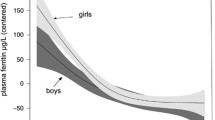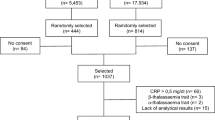Abstract
Background
Anemia is common among children in Aboriginal communities in Canada. The objectives of this study were to determine the prevalence of anemia and to identify its associated risk factors among young children in Aboriginal communities in northern Ontario and Nunavut.
Methods
115 children from one Inuit and two Cree First Nations communities participated. We collected information on demographic and dietary factors and measured hemoglobin (Hb), ferritin (SF), serum transferrin receptor (sTfR) and Helicobacter pylori IgG antibodies. Odds ratios and 95% confidence intervals were determined to examine risk factors associated with anemia and iron deficiency (ID) and further analyzed using stepwise regression procedures.
Results
Prevalence of anemia (Hb<110 g/L) was 36.0%. Iron deficiency (sTfR>8.5 mg/L) was present in 27.6% of the study population. Approximately 53.3% had depleted iron stores (SF<12 Jg/L). Consumption of cow/evaporated milk was the only independent risk factor associated with anemia. Infection with H. pylori and prolonged consumption of breastmilk were also associated, although not independently, with anemia. Formula intake was negatively associated with ID.
Interpretation
The prevalence of anemia in Aboriginal children was eight times higher than among similar populations in urban Canada and was especially high among Inuit children. ID was the major cause of anemia, but not the only one, since 10% of anemic children were not iron deficient. Given that the consumption of cow/evaporated milk was found to be a significant independent risk factor associated with anemia, public health strategies should include promotion of breastfeeding, combined with iron-rich complementary foods, while addressing socio-economic conditions that may be preventing these practices from being adopted. H. pylori may be a major contributing factor to anemia, thus improvements in water quality and sanitation also need to be considered.
Résumé
Contexte
L’anémie est une affection courante touchant les enfants au sein des communautés autochtones du Canada. Cette étude visait à déterminer la prévalence de l’anémie et à cerner les facteurs de risque associés parmi les jeunes enfants des communautés autochtones du Nord de l’Ontario et du Nunavut.
Méthode
Cent quinze enfants d’une communauté inuite et de deux communautés des Premières nations cries ont participé. Des facteurs démographiques et diététiques ont été pris en compte, et les taux d’hémoglobine (Hb), de ferritine (FS), du récepteur soluble de la transferrine (Rs-TF) et des anticorps de type IgG dirigés contre Helicobacter pylori ont été mesurés. Des rapports de cotes (RC) et des intervalles de confiance à 95% ont été déterminés pour examiner les facteurs de risque associés à l’anémie et à la carence en fer, puis analysés plus en détail avec des méthodes de régression multiple pas-à-pas.
Résultats
La prévalence de l’anémie (Hb<110 g/L) était de 36,0%. La carence en fer (Rs-TF>8,5 mg/L) était présente dans 27,6% de la population étudiée. Le stock de fer était épuisé dans approximativement 53,3% des cas (FS<12 Jg/L). La consommation de lait de vache ou de lait concentré était le seul facteur de risque indépendant associé à l’anémie. Les infections à H. pylori et la consommation prolongée de lait maternel étaient également associées, bien que non indépendamment, à l’anémie. La prise de préparations lactées pour nourrisson était inversement associée à la carence en fer.
Interprétation
La prévalence de l’anémie était huit fois plus élevée chez les enfants autochtones que chez les populations similaires du Canada urbain, et elle était particulièrement élevée parmi les enfants inuits. La carence en fer était la principale cause d’anémie, mais pas la seule, puisque 10% des enfants anémiés n’avaient pas de carence en fer. étant donné que la consommation de lait de vache ou de lait concentré s’est avérée être un facteur de risque indépendant significatif associé à l’anémie, les stratégies de santé publique devraient inclure la promotion de l’allaitement maternel, combinée à une alimentation complémentaire riche en fer, tout en tenant compte des conditions socio-économiques qui peuvent empêcher l’adoption de ces pratiques. H. pylori apparaît comme un facteur important contribuant à l’anémie, ainsi des améliorations de la qualité de l’eau et de l’hygiène doivent également être prises en compte.
Similar content being viewed by others
References
Zlotkin SH, Ste-Marie M, Kopelman H, Jones A, Adam J. The prevalence of iron depletion and iron-deficiency anaemia in a randomly selected group of infants from four Canadian cities. Nutr Res 1996;16:729–33.
Willows N, Dewailly E, Gray-Donald K. Anaemia and iron status in Inuit infants from Northern Quebec. Can J Public Health 2000;91(6):407–10.
Willows N, Morel J, Gray-Donald K. Prevalence of anaemia among James Bay Cree infants of northern Quebec. CMAJ 2000;162(3):323–26.
Hodgins S, Dewailly E, Chatwood S, Bruneau S, Bernier F. Iron-deficiency in Nunavik: Pregnancy and infancy. Int J Circumpolar Health 1998;57(Suppl 1):135–40.
Sawchuk P, Rauliuk M, Kotaska A, Townsend S, Wilson E, Starr M. Infant nutrition program effectively prevents iron-deficiency anaemia in a First Nations community. Int J Circumpolar Health 1998;57(Suppl 1):189–93.
Neander WL, Morse JM. Tradition and change in the Northern Alberta Woodlands Cree: Implications for infant feeding practices. Can J Public Health 1989;80(3):190–94.
Moffatt MEK. Nutritional problems of native Canadian mothers and children. Can Fam Phys 1989;35:377–82.
Willows ND. Anaemia in James Bay Cree Infants of Northern Quebec. [Doctoral Thesis] Montreal, Quebec: McGill University, 2000.
McKeown I, Orr P, Macdonald S, Kabani A, Brown R, Coghlan G, et al. Helicobacter pylori in the Canadian arctic: Seroprevalence and detection in community water samples. Am J Gastroenterol 1999;94(7):1823–29.
Yip R, Limburg PJ, Ahlquist DA, Carpenter HA, O’Neill A, Kruse D, at al. Pervasive occult gas-trointestinal bleeding in an Alaska native population with prevalent iron deficiency. Role of Helicobacter pylori gastritis. JAMA 1997;277(14):1135–39.
Parkinson AJ, Gold BD, Bulkow L, Wainwright RB, Swaminathan B, Khanna B, et al. High prevalence of Helicobacter pylori in the Alaska native population and association with low serum ferritin levels in young adults. CDLI 2000;7(6):885–88.
Christofides A, Zlotkin S, Schauer C. Impact of micronutrient sprinkles for the treatment and prevention of iron deficiency in Canadian first nations and Inuit infants 4–18 months old. FASEB J 2003;17A:S1102.
Statistics Canada. https://doi.org/www.statcan.ca. Community Profiles. Census, 2001.
Gibson RS. Principles of Nutritional Assessment. New York, NY: Oxford University Press, 1990.
Native Foods and Nutrition. Ottawa, ON: Minister of Natural Health and Welfare, 1994.
Cohen AR, Seidi-Friedman J. HemoCue system for hemoglobin measurement. Evaluation in anemic and nonanemic children. Am J Clin Pathol 1988;90:302–5.
Miles LEM, Lipschitz DA, Bieber CP, Cook JD. Measurement of serum ferritin by a 2-site immunoradiometric assay. Anal Biochem 1974;61:209–24.
Zlotkin S, Antwi KY, Schauer C, Yeung G. Use of microencapsulated iron (II) fumarate sprinkles to prevent recurrence of anaemia in infants and young children at high risk. Bull WHO 2003;81(2):108–15.
Wieringa FT, Dijkhuizen MA, West CE, Northrop-Clewes CA, Muhilal. Estimation of the effect of the acute phase response on indicators of micronutrient status in Indonesian infants. J Nutr 2002;132:3061–66.
Friel JK, Andrews WL, Edgecombe C, McCloy UR, Belkhode S, L’Abbe M, et al. Eighteen- month follow-up of infants fed evaporated milk formula. Can J Public Health 1999;90(4):240–43.
Complementary feeding of young children in developing countries: A review of current scientific knowledge. Geneva, Switzerland: WHO, 1998.
Cook JD, Dassenko S, Skikne BS. Serum transferrin receptor as an index of iron absorption. Br J Haematol 1990;75(4):603–9.
Ritchie B, McNeil Y, Brewster DR. Soluble transferrin receptor in Aboriginal children with a high prevalence of iron deficiency and infection. Trop Med Int Health 2004;9(1):96–105.
Healthy Active Living Committee, Canadian Paediatric Society (CPS). Healthy active living for children and youth. Paediatrics & Child Health 2002;7(5):339–45.
Author information
Authors and Affiliations
Corresponding author
Additional information
A correction to this article is available at https://doi.org/10.1007/BF03405192
Rights and permissions
About this article
Cite this article
Christofides, A., Schauer, C. & Zlotkin, S.H. Iron Deficiency and Anemia Prevalence and Associated Etiologic Risk Factors in First Nations and Inuit Communities in Northern Ontario and Nunavut. Can J Public Health 96, 304–307 (2005). https://doi.org/10.1007/BF03405171
Received:
Accepted:
Published:
Issue Date:
DOI: https://doi.org/10.1007/BF03405171




